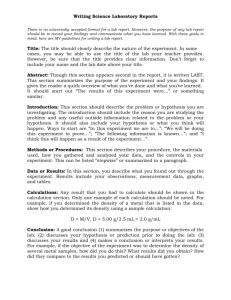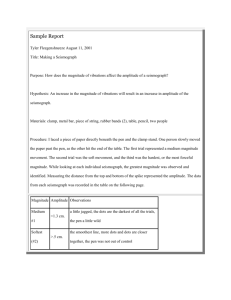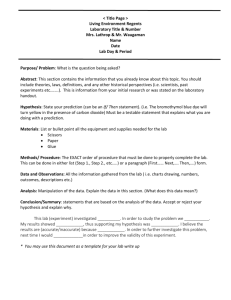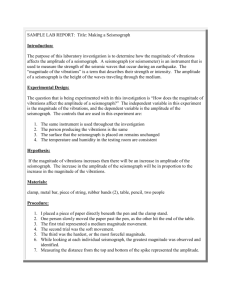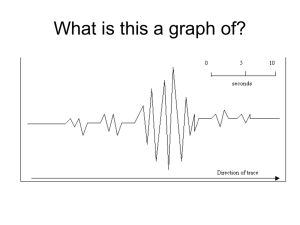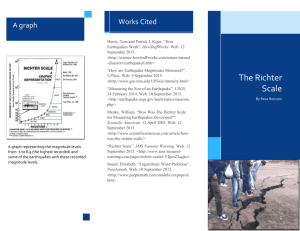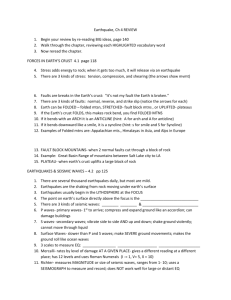Lab Report Requirements/Sample Report
advertisement
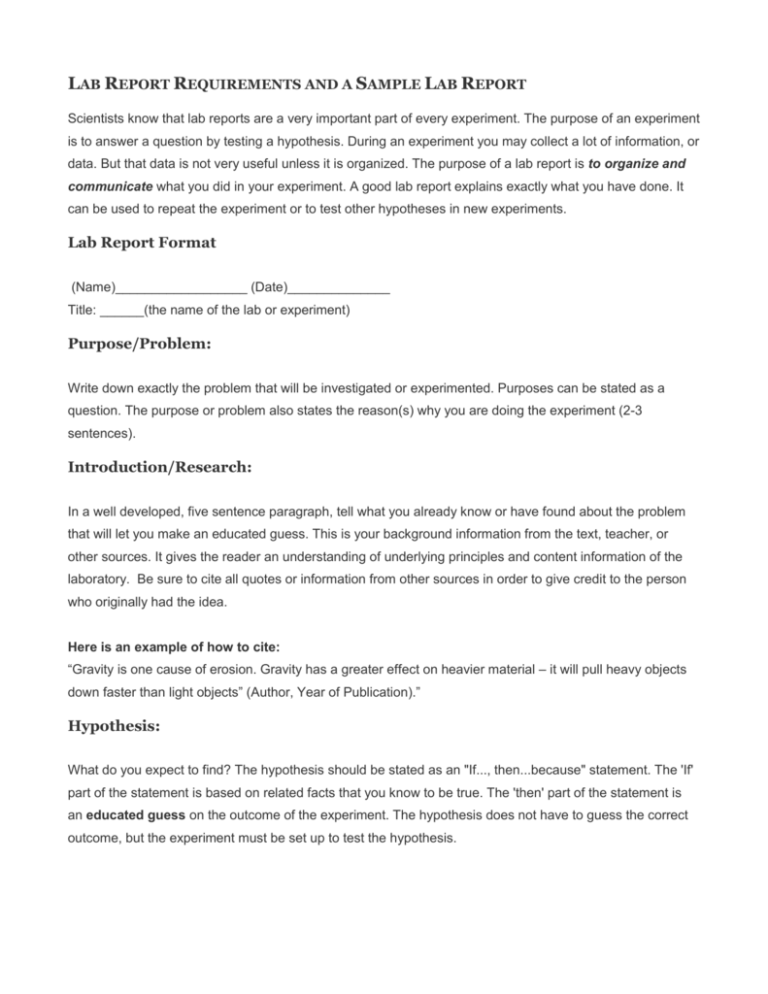
LAB REPORT REQUIREMENTS AND A SAMPLE LAB REPORT Scientists know that lab reports are a very important part of every experiment. The purpose of an experiment is to answer a question by testing a hypothesis. During an experiment you may collect a lot of information, or data. But that data is not very useful unless it is organized. The purpose of a lab report is to organize and communicate what you did in your experiment. A good lab report explains exactly what you have done. It can be used to repeat the experiment or to test other hypotheses in new experiments. Lab Report Format (Name)__________________ (Date)______________ Title: ______(the name of the lab or experiment) Purpose/Problem: Write down exactly the problem that will be investigated or experimented. Purposes can be stated as a question. The purpose or problem also states the reason(s) why you are doing the experiment (2-3 sentences). Introduction/Research: In a well developed, five sentence paragraph, tell what you already know or have found about the problem that will let you make an educated guess. This is your background information from the text, teacher, or other sources. It gives the reader an understanding of underlying principles and content information of the laboratory. Be sure to cite all quotes or information from other sources in order to give credit to the person who originally had the idea. Here is an example of how to cite: “Gravity is one cause of erosion. Gravity has a greater effect on heavier material – it will pull heavy objects down faster than light objects” (Author, Year of Publication).” Hypothesis: What do you expect to find? The hypothesis should be stated as an "If..., then...because" statement. The 'If' part of the statement is based on related facts that you know to be true. The 'then' part of the statement is an educated guess on the outcome of the experiment. The hypothesis does not have to guess the correct outcome, but the experiment must be set up to test the hypothesis. Materials/Supplies: This is a list of all equipment and chemicals used to do the experiment. Please include quantities (amounts). Be as specific as possible. Procedure: The procedure tells exactly what you did. It should include what your independent variable was and how it was tested. Make statements in the past tense. Be specific. The procedure you use affects the results. So, it is important to be accurate in explaining what you did. It should also include what types of observations or data was recorded throughout the experiment, which is your dependent variable. The procedure is written in paragraph form, not a sequential list of steps. Observations and Data: The observations tell exactly what happened when you did the lab. An observation is measurable information that comes to you through your senses. Results include experimental (raw) data in the form of well-labeled tables, graphs, drawings and other observations. There are two types of observations. Qualitative observations include color changes, smells you notice, or taste. Quantitative observations include measurements or anything that is recorded with numbers. Place your observations and data in this section without discussion or comment. This is where you include any calculations made during the experiment. Conclusion/Summary: Conclusions explain your observations and describe how your data relates to the problem. It is written in paragraph/essay form and should include why you did this experiment (restate the purpose/problem). You should explain in your own words what you found out or discovered. Your conclusion should state whether or not the data confirms or rejects your hypothesis. Discuss any errors as well as any patterns you see. Part of the conclusion may be a new hypothesis based on your findings and suggestions for testing the new hypothesis in a different experiment. You may also make any predictions you would expect based on what you discovered. Other “Do’s” and “Don’ts”: Do draw a picture of the experiment in your observations. Label all parts of your experimental set-up. Don’t say that the purpose was accomplished and then say nothing substantially more. You must include data from the lab results to demonstrate that the purpose was accomplished. Don’t state the procedure again OR list the data again. It was already listed in the data (chart, table, etc.) section. You are to analyze the data and draw conclusions. Sample Report Tyler Smith August 11, 2013 Title: Making a Seismograph Purpose: Scientists have been using technology for centuries in order to understand the natural world. In this lab, a seismograph will be constructed in order to draw conclusions about the relationship between earth’s vibrations and the amplitude of a seismic wave. The goal of the experiment is to answer: How does the magnitude of vibrations affect the amplitude of a seismograph? Introduction/Research: A seismograph is the device that scientists use to measure earthquakes. The goal of a seismograph is to accurately record the motion of the ground during a quake (Houghton Mifflin Hartcourt, 2012). The main problem that must be solved in creating a seismograph is that when the ground shakes, so does the instrument. Therefore, most seismographs involve a large mass of some sort. You could make a very simple seismograph by hanging a large weight from a rope over a table. By attaching a pen to the weight and taping a piece of paper to the table so that the pen can draw on the paper, you could record tremors in the Earth's crust (earthquakes). If you used a roll of paper and a motor that slowly pulled the paper across the table, you would be able to record tremors over time. However, it would take a pretty large tremor for you to see anything. In a real seismograph, levers or electronics are used to magnify the signal so that very small tremors are detectable. A big mechanical seismograph may have a weight attached that weighs 1,000 pounds (450 kg) or more, and it drives a set of levers that significantly magnify the pen's motion (www.howstuffworks.com, 2013). The Richter scale is a standard scale used to compare earthquakes. It is a logarithmic scale, meaning that the numbers on the scale measure factors of 10. So, for example, an earthquake that measures 4.0 on the Richter scale is 10 times larger than one that measures 3.0. On the Richter scale, anything below 2.0 is undetectable to a normal person and is called a microquake. Microquakes occur constantly. Moderate earthquakes measure less than 6.0 or so on the Richter scale. Earthquakes measuring more than 6.0 can cause significant damage. The biggest quake in the world since 1900 scored a 9.5 on the Richter scale. It rocked Chile on May 22, 1960 (Science Explorer, 2011). Hypothesis: If we increase the magnitude of vibrations, then we will observe an increase in amplitude of the seismograph, because larger vibrations will produce larger waves. Materials: clamp, metal bar, piece of string, rubber bands (2), table, pencil, two people Procedure: I laced a piece of paper directly beneath the pen and the clamp stand. One person slowly moved the paper past the pen, as the other hit the end of the table. The independent variable was the amount of vibration, which was caused by movement. The first trial represented a medium magnitude movement. The second trial was the soft movement, and the third was the hardest, or the most forceful magnitude. While looking at each individual seismograph, the greatest magnitude was observed and identified (Magnitude was the dependent variable). Measuring the distance from the top and bottom of the spike represented the amplitude. The data from each seismograph was recorded in the table on the following page. Observations: Experimental Set-up Magnitude Amplitude Observations Medium #1 Softest (#2) Hardest (#3) >1.3 cm. >.5 cm. 2 cm. a little jagged, the dots are the darkest of all the trials, the pen a little wild the smoothest line, more dots and dots are closer together, the pen was not out of control the most jagged, doesn't really have a certain path, the least amount of dots, pen way out of control Conclusion: This lab investigated how the magnitude of vibrations affects the amplitude of a seismograph. In order to study the problem we created three magnitudes of movement (independent variable) and measured the amplitude (dependent variable) of each with a seismograph. My results showed the trial with the greatest amplitude was trial three because the table was being hit with the most force, making the table and the pen move more than the other three trials. The trial with the least amplitude was trial two because the table was hit with the least amount of pressure. While observing the experiment, I noticed that the more vibrations or higher magnitude resulted in a higher amplitude on the seismograph. The harder the table was being hit, the higher the amplitude rose. This proves my hypothesis was correct. I believe the results are accurate because while the experiment was in progress, the frame moved at the same rate as the table. It was proven in trials one through three that the increased magnitude of table movement caused the greatest amplitude differences on the seismograph. It is clear, therefore, that the movement of the frame also corresponds to the amplitude of the seismograph. The bar and marker shared the same relationship with the table and the frame. The more the frame moved, the greater the amplitude on the seismograph. In order to further investigate this problem, next time I would try the experiment on a different surface and would add additional movements of varying forces for further readings on the seismograph.
